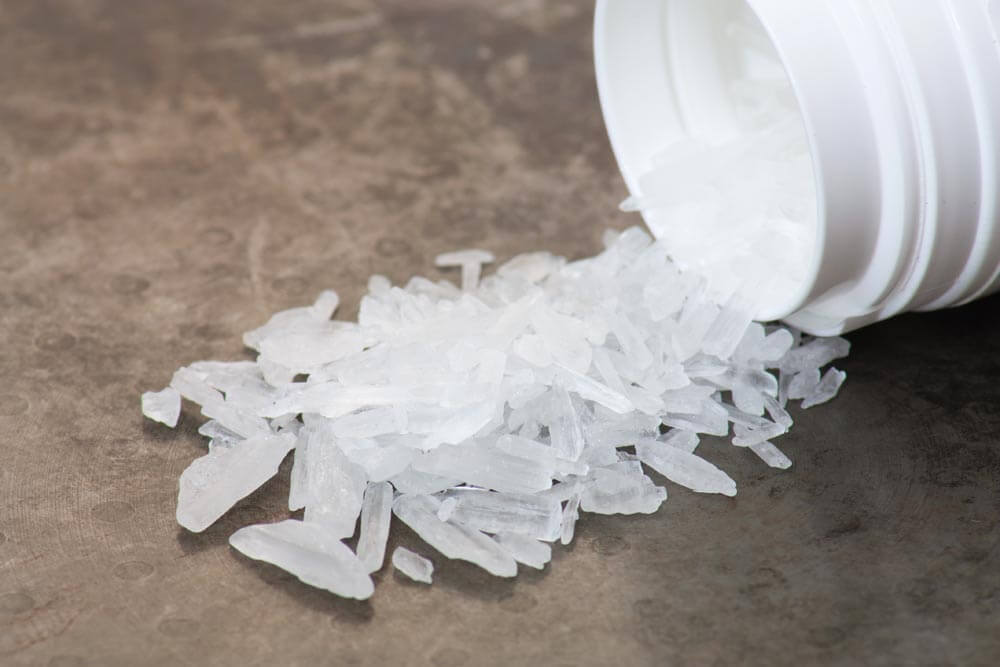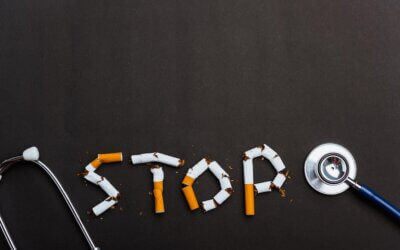 Amphetamines ranging from methamphetamine to crystal meth are among the most addictive, dangerous, and harmful drugs on the market. Some 1.6 million Americans struggle with methamphetamine and crystal meth abuse, with more than half a million estimated to be addicted. While amphetamines are frequently used in prescription medication, meth is considered more dangerous because of its unregulated production, often mixing harmful chemicals to create a drug as cheaply and as efficiently as possible. This leads to dangerous and harmful side effects not always present with prescription drugs. And, with different ways to take drugs including smoking, users suffer from more side effects, which will make it easier to see if someone is on meth.
Amphetamines ranging from methamphetamine to crystal meth are among the most addictive, dangerous, and harmful drugs on the market. Some 1.6 million Americans struggle with methamphetamine and crystal meth abuse, with more than half a million estimated to be addicted. While amphetamines are frequently used in prescription medication, meth is considered more dangerous because of its unregulated production, often mixing harmful chemicals to create a drug as cheaply and as efficiently as possible. This leads to dangerous and harmful side effects not always present with prescription drugs. And, with different ways to take drugs including smoking, users suffer from more side effects, which will make it easier to see if someone is on meth.
If your loved one is using or addicted to meth, chances are, you’ll notice. Methamphetamines and crystal meth are hard drugs with severe side effects that are quite often very quickly noticeable. Chances are, you’ll notice something wrong right away, even if you pass it off as them being sick.
Symptoms of Meth Use
Meth is a stimulant drug, meaning that users immediately experience a high accompanies by an increase in energy. Most users experience a marked increase in energy, alertness, motivation, and mania over the first 12 hours of the high. This “manic” period may be accompanied by increased agitation, respiration and energy. Symptoms typically begin just 15 minutes after usage. Depending on the drug and how long the user keeps using, it can result in periods of wakefulness exceeding 36 hours.
- Increased activity
- Increased blood pressure
- Faster breathing
- Dilated pupils
- Sweating
- Loss of appetite/refusing to eat
- Insomnia /inability or refusal to sleep
- Paranoia
- Irritability
- Nausea
- Shaking and tremors
- Dry mouth and bad breath
- Headache
- Tension and teeth grinding or jaw clenching
After the drug begins to wear off, users experience the opposite effect. Most will sleep, often for periods of 12-30 hours. Most will show intense cold-like symptoms with runny nose, red eyes, fatigue, depression and insomnia following that initial crash. This is especially noticeable if depression and fatigue are out of character for the person but will likely be passed off as having the flu or a stomach bug the first few times.
Long-Term Meth Abuse
 The longer someone uses meth, the worse symptoms will get. The first and most noticeable side effects will likely be physical, simply because physical conditions don’t occur as gradually and can come as a shock. For example, formerly healthy individuals may have skin sores, tooth decay, severe weight loss, repetitive ticks or scratching, paranoia, depression and anxiety.
The longer someone uses meth, the worse symptoms will get. The first and most noticeable side effects will likely be physical, simply because physical conditions don’t occur as gradually and can come as a shock. For example, formerly healthy individuals may have skin sores, tooth decay, severe weight loss, repetitive ticks or scratching, paranoia, depression and anxiety.
Most people notice these symptoms and think their loved one is sick. They later connect the dots and trace the cause back to addiction, especially as addiction causes drug use to become more erratic and more frequent.
Energy Dips – Meth is a stimulant, causing the user to feel an emotional and physical high. When the drug wears off, that individual goes from being on top of the world to on the bottom, and thoroughly worse for the wear. That’s exacerbated by the drug’s impact on the brain, where users experience a process known as emotional blunting. The brain responds to high levels of dopamine and serotonin by simply producing less on its own. Individuals may struggle to show emotion and respond to normal interaction because they’re struggling to feel anything at all. For this reason, some 95% of regular meth users experience depression when not using. If your loved one is erratically experiencing highs and lows of energy, mood and attitude, it may be because of meth usage (although bipolar disorder has similar symptoms).
Manipulative Behavior – Emotional blunting also means that individuals feel less when they do something wrong. Your loved one may seem to lose their moral compass, resulting in lying, manipulation, deceit and purposely hurtful behavior. You may feel they’ve become a different person. That’s likely because the reward circuit in their brain is no longer triggering based on social interaction, meaning they’re free to do whatever when chasing their next high. The good news is that emotional blunting goes away after the brain has time to recover from substance abuse.
Erratic Sleep – Most people will have some erratic sleeping patterns, but persons struggling with meth abuse take that to an extreme. A heavy user will stay up, sometime for more than two days at a time, and then crash. This results in a pattern of extreme energy followed by extreme sleep or fatigue.
Tics – Meth users almost universally develop rhythmic movements and tics such as scratching, teeth grinding and muscles jumping. This may be combined with paranoia, where the individual thinks there is something under their skin.
Tooth Decay – Meth smokers are the first to develop tooth problems, but meth usage also dries out the mouth and results in tooth grinding. This frequently damages the teeth, resulting in yellowing and rot. This is often exacerbated by the fact that meth users are drawn to sugary drinks when high and won’t likely remember to brush teeth after.
Weight Loss – Most meth users will experience rapid weight loss because of metabolism and energy boosts during high periods. Here, it’s important to note that rapid and unexplained weight loss is also a symptom of something being seriously wrong, so it’s important to take your loved one to a doctor whether they’re using meth or not.
Get Your Questions Answered Now.
Paraphernalia
Meth users often rely on paraphernalia to take their drug of choice. This might include glass pipes, needles, ropes or pipes, unexplained blood, etc. If you find physical records someone has used, they are likely using to the point where they no longer care about hiding it.
Psychological Effects of Meth
Meth changes a person’s appearance and personality. Methamphetamine causes side effects like paranoia and anxiety, aggression, emotional blunting and memory problems. Over time, each of these gets worse, to the point where your loved one may be difficult to recognize as the same person they were before.
This can manifest in manipulative behavior to get money. In outright theft. In hiding drug use and lying about it. And, in manipulating people around them to continue to benefit from a situation.
However, it’s often easy to recognize in the form of increased agitation, paranoia, memory and cognitive capabilities. Early usage is characterized by individuals experiencing these problems while high. After long-term abuse, these side effects can be constant.
- Psychosis
- Hallucinations (such as of bugs crawling)
- Delusions
- Extreme paranoia
- Aggression
- Memory problems
At the height of meth addiction, users may enter a state known as tweaking, where they don’t sleep for 2 or more days. This state can last as long as two weeks, with severe physical and psychological side effects. Someone who is tweaking will likely look similar to someone being intensely agitated while drunk, with agitated and rhythmic movements, jerking and stumbling walking and fast talk that doesn’t make any sense. Tweaking people are dangerous, irrational, aggressive, and paranoid. You should also work to get them to a hospital, because the state is extremely dangerous and may result in collapse, organ failure and death.
Getting Help with Meth Addiction
 Nearly half a million people are addicted to meth. Millions more try the drug and remain regular users. Both are intensely harmful. Meth is a deeply addictive drug, typically resulting in chemical dependence, psychological addiction and seeking behavior. Getting real help, including medical detox to prevent dangerous side-effects during withdrawal, a personalized behavioral therapy program to treat actual underlying issues of drug use, and support while the individual rebuilds their life is essential to getting clean and rebuilding their life.
Nearly half a million people are addicted to meth. Millions more try the drug and remain regular users. Both are intensely harmful. Meth is a deeply addictive drug, typically resulting in chemical dependence, psychological addiction and seeking behavior. Getting real help, including medical detox to prevent dangerous side-effects during withdrawal, a personalized behavioral therapy program to treat actual underlying issues of drug use, and support while the individual rebuilds their life is essential to getting clean and rebuilding their life.
Meth users suffer from physical and psychological health problems, can create problems for themselves while manic and out of control, and will actively harm themselves and those around them. Getting into rehab is the first step to healing the damage done.
If you or your loved-one is seeking help for opioid use or another addiction, call us at (714) 400-2048 and look into our recovery programs. Our Drug and Alcohol Treatment Center in Huntington Beach helps clients by providing them with addiction intervention services, detox, and residential addiction treatment.
Other Articles you might be interested in:
Understanding Detox in Orange County
Detoxification, or detox, is the initial phase of recovery from...
Understanding Signs of Addiction with Broadway Treatment Center
Recognizing the signs of addiction is crucial for early...
How to Overcome Addiction
Overcoming addiction is a transformative journey that requires a...



